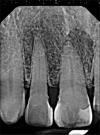Renal cell carcinoma metastatic to the maxillary gingiva: A case report and review of the literature
- PMID: 29491617
- PMCID: PMC5824500
- DOI: 10.4103/jomfp.JOMFP_69_17
Renal cell carcinoma metastatic to the maxillary gingiva: A case report and review of the literature
Abstract
Tumor metastasis to the oral cavity is rare and is usually an indication of late-stage disease and poor prognosis. While, there are reports of renal cell carcinoma (RCC) metastatic to oral cavity, vast majority of them are to the jaw. Herein, we present a case of a 78-year-old woman with RCC metastasis limited to the oral soft tissue without any bone involvement. As the lesion solely involved maxillary gingiva, it clinically mimicked that of a pyogenic granuloma, which is a reactive, nonneoplastic condition. This case was further complicated as the patient was unaware of primary cancer and appeared to be in good physical health. Her oral metastasis marked the initial manifestation of an otherwise silent primary renal cancer.
Keywords: Maxillary gingiva; metastatic cancer; pyogenic granuloma; renal cell carcinoma.
Conflict of interest statement
There are no conflicts of interest.
Figures




Similar articles
-
Metastatic Renal Cell Carcinoma Presenting a Maxillary Mucosal Lesion as a First Visible Sign of Disease: A Case Report and Review of Literature.Diagnostics (Basel). 2025 Apr 7;15(7):938. doi: 10.3390/diagnostics15070938. Diagnostics (Basel). 2025. PMID: 40218288 Free PMC article.
-
Renal cell carcinoma metastasis to the maxillary bone successfully treated with surgery after vascular embolization: a case report.J Med Case Rep. 2020 Oct 12;14(1):193. doi: 10.1186/s13256-020-02522-6. J Med Case Rep. 2020. PMID: 33040735 Free PMC article. Review.
-
A Clinical Report of Solitary Gingival Overgrowth in a Young Female Patient.J Pharm Bioallied Sci. 2019 May;11(Suppl 2):S491-S494. doi: 10.4103/JPBS.JPBS_8_19. J Pharm Bioallied Sci. 2019. PMID: 31198394 Free PMC article.
-
Three Synchronous Atypical Metastases of Clear Cell Renal Carcinoma to the Maxillary Gingiva, Scalp and the Distal Phalanx of the Fifth Digit: A Case Report.J Oral Maxillofac Surg. 2016 Jun;74(6):1286.e1-9. doi: 10.1016/j.joms.2016.01.054. Epub 2016 Feb 13. J Oral Maxillofac Surg. 2016. PMID: 26954558
-
[A rare form of metastasis of renal cell cancer. A case report of intra-oral soft tissue metastasis].Urologe A. 1989 Nov;28(6):355-8. Urologe A. 1989. PMID: 2690442 Review. German.
Cited by
-
Renal Cell Carcinoma Metastasizing to Oral Soft Tissues: Systematic Review.Avicenna J Med. 2024 May 6;14(2):75-109. doi: 10.1055/s-0044-1782202. eCollection 2024 Apr. Avicenna J Med. 2024. PMID: 38957158 Free PMC article. Review.
-
A systematic review of metastatic lesions to the oral and maxillofacial regions among Japanese people.Jpn Dent Sci Rev. 2025 Dec;61:155-166. doi: 10.1016/j.jdsr.2025.06.001. Epub 2025 Jun 25. Jpn Dent Sci Rev. 2025. PMID: 40657471 Free PMC article. Review.
-
Differential Diagnosis between Oral Metastasis of Renal Cell Carcinoma and Salivary Gland Cancer.Diagnostics (Basel). 2021 Mar 12;11(3):506. doi: 10.3390/diagnostics11030506. Diagnostics (Basel). 2021. PMID: 33809250 Free PMC article. Review.
-
Tumor Metastasis to the Oral Soft Tissues and Jaw Bones: A Retrospective Study and Review of the Literature.Clin Exp Dent Res. 2024 Dec;10(6):e70011. doi: 10.1002/cre2.70011. Clin Exp Dent Res. 2024. PMID: 39420710 Free PMC article. Review.
-
Metastatic renal cell carcinoma to the oral cavity as first sign of disease: A case report.Clin Case Rep. 2020 Jul 14;8(8):1517-1521. doi: 10.1002/ccr3.2923. eCollection 2020 Aug. Clin Case Rep. 2020. PMID: 32884786 Free PMC article.
References
-
- Hirshberg A, Shnaiderman-Shapiro A, Kaplan I, Berger R. Metastatic tumours to the oral cavity-pathogenesis and analysis of 673 cases. Oral Oncol. 2008;44:743–52. - PubMed
-
- Brufau BP, Cerqueda CS, Villalba LB, Izquierdo RS, González BM, Molina CN, et al. Metastatic renal cell carcinoma: Radiologic findings and assessment of response to targeted antiangiogenic therapy by using multidetector CT. Radiographics. 2013;33:1691–716. - PubMed
-
- Bianchi M, Sun M, Jeldres C, Shariat SF, Trinh QD, Briganti A, et al. Distribution of metastatic sites in renal cell carcinoma: A population-based analysis. Ann Oncol. 2012;23:973–80. - PubMed
Publication types
LinkOut - more resources
Full Text Sources
Other Literature Sources
Research Materials

